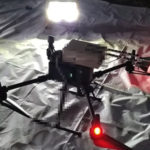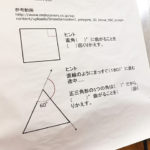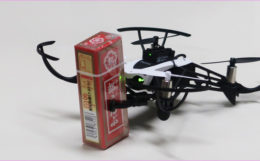Researchers at Osaka University demonstrate ultra-wideband radars using fiber-optic communications technologies
A team of researchers at Osaka University, together with Rediscovery of the wheel Inc., and JFE Shoji Electronics Corporation, has developed an ultra-wideband radar system, which can be mounted on drones. With the cooperation of the Tokuyama Plant of Idemitsu Kosan Co., Ltd., a drone equipped with the radar was flown in a chimney with a height of 150 m during a regular inspection period (Fig. 1). The researchers have succeeded in inspecting the thickness of the lining material, which covers the chimney wall as a protection layer.
“In general, millimeter-wave radars with operation frequencies at 24 GHz, 60 GHz, 77 GHz, and 79 GHz are commonly used mainly for in-vehicle applications. However, due to the limitations of radio-wave frequencies and their bandwidths, the material-penetration capability and resolution are insufficient, and neither of them can be applied to the above diagnosis of the inner wall of the chimney,” explains Assistant Professor Yi.
The researchers have been developing a radar system that utilizes optical communications technologies (Fig. 2). In this system, two different wavelengths of optical signals are first generated in the fiber-optic communications wavelength (1.55 μm) band. When the optical signals are transmitted over an optical fiber cable and applied to a photodiode, which converts the optical signal into the electrical (RF) signal, it is possible to generate radio waves with a frequency corresponding to the wavelength difference between the two optical signals. By precisely controlling the optical wavelength, radio waves can be generated in any band in the range of approximately 1 GHz to 1000 GHz. The position of the reflection point (front or back surface of the object) is known by irradiating the object while changing the frequency of this radio wave and calculating the amplitude phase relationship between the radio wave reflected and returned from the object and the original radio wave.
more https://resou.osaka-u.ac.jp/en/research/2021/20210528_1




























 プログラミング教育ポータル
プログラミング教育ポータル ICT教育ニュース
ICT教育ニュース fabcross
fabcross ドローン操縦プログラミングブック
ドローン操縦プログラミングブック
コメント